Media | Articles
These three-pedal bruisers are a dying breed
Until the 1960s, big, brawny, front-engine GT cars were the gold standard. On the Autostrada or the Autobahn, a powerful two-seater or 2+2 coupe was a viable alternative to a light plane. With a big Ferrari, Aston, or Maserati at your disposal, you could have breakfast in Marseille and dinner in Munich without breaking a sweat. The advent of mid-engine cars like the Lamborghini Miura and Ferrari Berlinetta Boxer blunted the top-dog status of the front-engine GT, but the sheer practicality of this classic layout meant that the genre persisted for decades.
Alas, the three-pedal GT is all but extinct and destined for a fast-track to collector status. Here are some of our favorites from the last 20 years, some of the last of their kind. They’re bargains (for the moment), even in spite of the frothy post-pandemic market.
2005–17 Aston Martin V8 Vantage
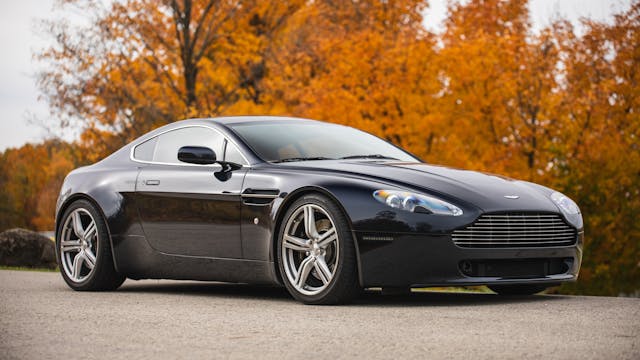
Since the introduction of the DB7 in the late 1990s, Aston Martin has been on a roll, producing one gorgeous car after the next. Of Aston’s modern lookers, though, the V8 Vantage and DB9 of the 2000s might be the high-water mark. Both are timelessly gorgeous, with ample modern performance to match. In Road & Track’s first road test of the V8 Vantage, the magazine called it one of the sexiest-looking cars on the planet with an exhaust note to match. Handling is superb with great balance, and Aston built in a ton of safety, even with the driver’s aids turned off. With 380 hp from a 4.3-liter dry-sump V-8, 0-to-60-mph comes up in 4.7 seconds. From 2009 the engine grew to 4.7 liters for 420 horses. A V-12 model was also available from 2009 on, but the V-8 cars are much more affordable, simpler to maintain, and just as nice to look at.
With its handy hatchback, the two-seater Vantage had more cargo space than the longer-wheelbase (but mechanically similar) DB9, which had a pair of small back seats. Maintenance costs are, well, befitting of the car’s exotic status, but with condition #2 (Excellent) values ranging from $54,000 to mid-$60K territory for most base-model V-8 coupes, the Vantage is an über-sexy car for the money as well as one that is likely done depreciating.
2014–19 Chevrolet Corvette (C7)
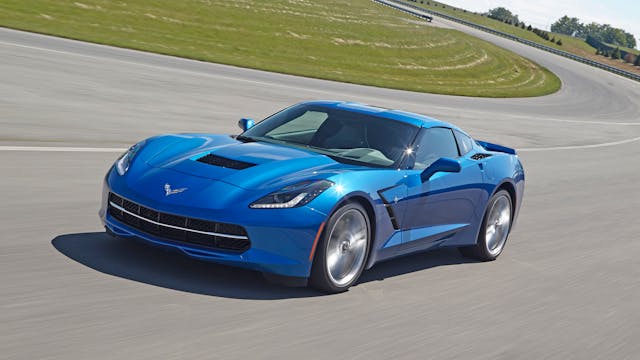
As the last front-engine Corvette (and the last one with an available manual), the C7 will always hold a sweet spot in the hearts of Corvette fans. As the truly spectacular car that it is, the C7 has enough going for it to tempt decidedly non-Corvette people, too. The car checks nearly every box—V-8 bellow, enviable Le Mans GT class history (thanks to the Pratt and Miller–prepared C7.R racers), and even an interior that feels far less downmarket than the Corvettes that precede it. C7 manuals have also acquired an impressive track record when it comes to reliability.
The dirty little secret of C7s is the fact that the base cars might just be the most satisfying ones to drive on a daily basis. The stock suspension and brakes work great for real-world driving, while 455 hp and 460 lb-ft from the base V-8 will rarely leave you yearning for more grunt. If you do some occasional track time, the Z51 package is wonderful, adding bigger Brembo brakes, performance exhaust for added sound and another 5 hp, an electronic limited-slip differential, and optional Magnetic ride control. With another 200 hp or so, the Z06 is an impressive car, but even with driver’s aids on, it can quickly tax the abilities of all but the most skilled drivers.
While C7 base cars have depreciated very little from their original price off the lot, they still offer more speed per dollar than almost anything on the road. They’re a screaming bargain in the high-$30,000 to low-$40,000 range.
2015–19 Jaguar F-Type
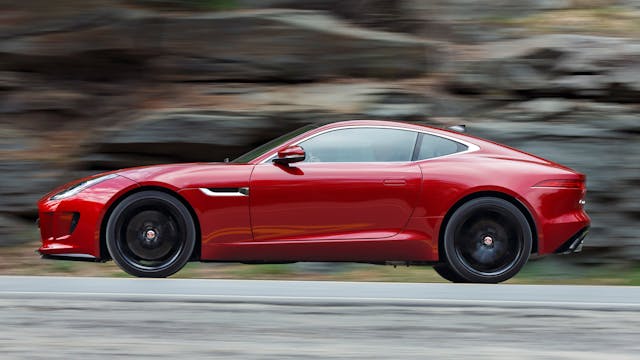
Ever since 1961, Jaguar has been trying to recapture the magic of the original E-Type. For the most part, the company has failed, but its latest attempt got closer than all the rest. Introduced in the spring of 2014, the F-Type was audaciously named as the direct lineal descendent of the E. And it is gorgeous, albeit not in the same sensational way that the E was at the Geneva Motor Show back in 1961. But other than low-volume exotic stuff like the XJR-15 and XJ220, it is the prettiest sports car Jaguar has produced since the E-Type.
And while the V-8 F-Types have the most intoxicating exhaust notes, and more power, it’s only the odd V-6 (essentially the V-8 block with two empty cylinders) that came with a manual transmission. It’s a low-key, elegant car that is quite reminiscent of a 1960s GT car, and decidedly off-brand for Jaguar. The F-Type also has a pretty good reputation for reliability, as Jaguars go. Jaguar didn’t release production figures for the manual (which disappeared after 2019), but at any given time, there are maybe two or three F-Type manuals for sale nationally, and that kind of rarity translates to solid potential for long-term collectability.
2002–07 Maserati Coupe and Spyder
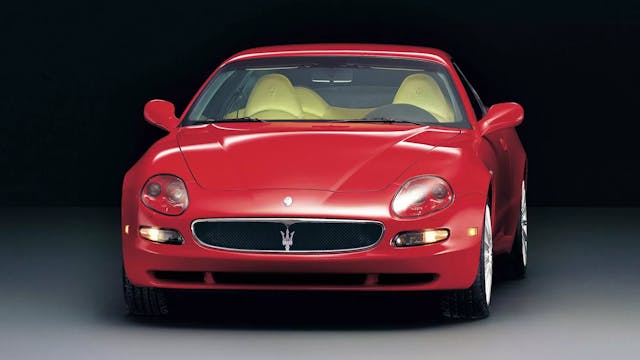
These two cars led Maserati’s resurgence in the U.S. as the first new Masers sold here since the wedgy/boxy Biturbo series of the 1980s and early ’90s. Neither the 2+2 Coupe, nor the shorter-wheelbase Spyder represented Italdesign’s/Giorgetto Giugiaro’s most striking work, but both were understated and handsome, and powered by a 4.2 liter, Ferrari-derived 385 hp V-8. Both available gearboxes were six-speeds, with one being a conventional three-pedal affair, and the other a two-pedal Cambiocorsa, a manual with an automated clutch. The former accounts for roughly ten percent of production and is far more desirable than the Cambiocorsa, which has a reputation for electrical and hydraulic problems. It likes to eat clutches, and the shifts are generally clunky.
Cambiocorsa values have accordingly taken a huge hit, which, to an extent, has driven down manual prices. Nice Coupes and Spyders can be had for well under $40,000. For a Giugiaro-designed Italian exotic with the heart of a Ferrari, that’s a serious deal.
2003–10 BMW 6 Series

If there’s a bête noire of automobile designers, it’s Chris Bangle, BMW’s chief of design during the 1990s and 2000s. Given the current vandalism that is taking place throughout the BMW lineup, however, some of Bangle’s designs like the E63/E64 6 Series and the Z4 Coupe are starting to look quite a bit better, “flame surfacing” and “Bangle Butts” notwithstanding. Truth be told, the E63/64 were actually finalized by Adrian van Hooydonk; but since they were based on a Bangle concept, Chris generally gets the blame/credit.
Introduced in 2003 after the original was discontinued in 1989, the second-generation 6 Series rides on a shortened version of the E60 5 Series platform. Wonky iDrive interface aside, these aren’t bad cars. The naturally aspirated N62 V-8 was the first to use a continuously variable-length intake manifold to go with variable valve-timing. The 4.4-liter 645Ci made 329 hp, and its replacement, the 4.8-liter unit found in the 650Ci, made about 33 more. Both engines require proper maintenance, and both still suffer from the usual BMW maladies like oil leaks and faulty valve-stem seals. But most importantly, coupes and convertibles were classic GTs and both could be had with a manual transmission. Manual 6 Series are rare but worth looking for, and probably won’t get any cheaper than they are now.
***
Marketplace
Buy and sell classics with confidence
Check out the Hagerty Media homepage so you don’t miss a single story, or better yet, bookmark it. To get our best stories delivered right to your inbox, subscribe to our newsletters.
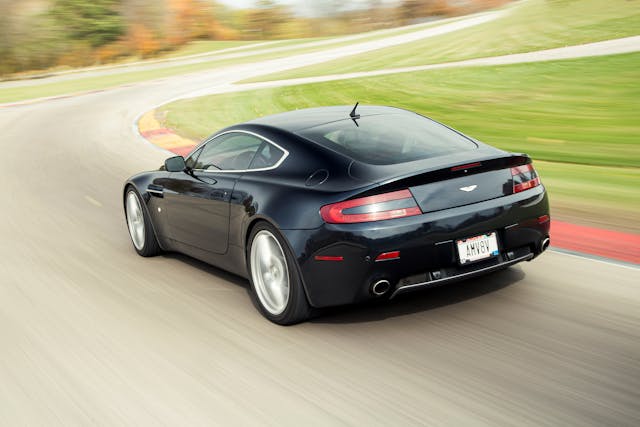



I was quite happy with my 2001 330Ci cabriolet with a 5-speed. After putting 71,000 trouble-free miles on it I opted for the all-new (at the time) AWD 3-series coupe in 2007 with a 6-speed manual. Before the 330Ci convertible I had a 1994 Acura Legend Coupe with a 6-speed manual… another great “3 pedal” car.
Nissan’s 350z, 370z and Z (non-nismo) (2003 – current) all available with 6 speed manuals!
Automatic transmissions are good for the disabled, fine for dizzy simpletons who see cars as no more than disposable appliances. All those calling themselves buffs, car guys, etc. are but posers if they want to drive a golf cart. You are n o t a gearhead if what you want are only a pair of go and whoa pedals cloaked in Walter Mitty bodywork. This goes all the more for aging teenyboppers driving “muscle” cars w/ automatic, power steering, power brakes.
A well designed, well engineered sport or road car luxe or not whether modern or a century old doesn’t need anything else. Synchromesh is nice, however. Alvis had it on first gear in 1936, Jaguar not ’til ’64.
Air conditioning?
Roll down the windows or stay home. Don’t insult a nice engine with power-robbing accessories. Less is more. Enjoy the ride; enjoy d r i v i n g. Otherwise, stay home, look at pictures on your computer.
I just have to shake my head. Some people that think they are true car guys are really just crabby old men.
I went out a couple years ago and bought an M6 Challenger RT Classic, knowing that the 3 pedal cars as well as ICE performance cars days are numbered. Chrysler even completely killed off the manual transmission for Hellcat in 2022 but brought it back for 2023. The numbers are low on the M6 production. I’m hoping to buy an M6 Jailbreak Hellcat before the prices go out of sight.
The Maserati and BMW scare me. Have a decent budget for repairing stuff, especially the Maserati.
For sheer fun it’s the S-2K hands down. Love it!!!
How is it that I didn’t know about the XKR 15 until now, and I’m an absolute Jaguar fan !
Agree with the BMW 6 series making the list. Hated it when it came out as it didn’t resemble the 635CSI but it’s grown on me.
All the cars mentioned deserve a place on this list and there’s more but if there had to be a Top 5, this is a solid selection.
My wife has a 2018 Z06 Corvette (7) speed manual and I have a C2 Restomod (6) speed Tremec. Would not have it any other way. Growing up we had no automatics, I learned how to drive in dad’s Model A, and my wife on my ’57 Chevy. There is nothing like going through the gears!
It was nice to see the BMW 6 series included in your listing. But you missed to most important BMW, the M6 with its 500 hp V10 engine. They only made 323 hardtop coupes and 378 convertibles world wide between 2007 and 2010 with the six speed manual three pedal gearbox. They may be rare, but oh so worth it when in comes to engaged driving. The V10 compares favorably to the motors from Audi/Lambo or LFA or Porsche. The cars are reasonably priced right now, but should appreciate in the future.
The BMW iDrive interface is just fine. Much better than any touch screen, you can access most functions without taking your eyes off the road.
Audi didn’t make the list? S5 manual or an RS5 for me please.
WRONG! F-type Jag looks truncated & stubby… like a hardtop Miata. It is the early years of the low long XK8 convertible that come closest to recalling the XKE